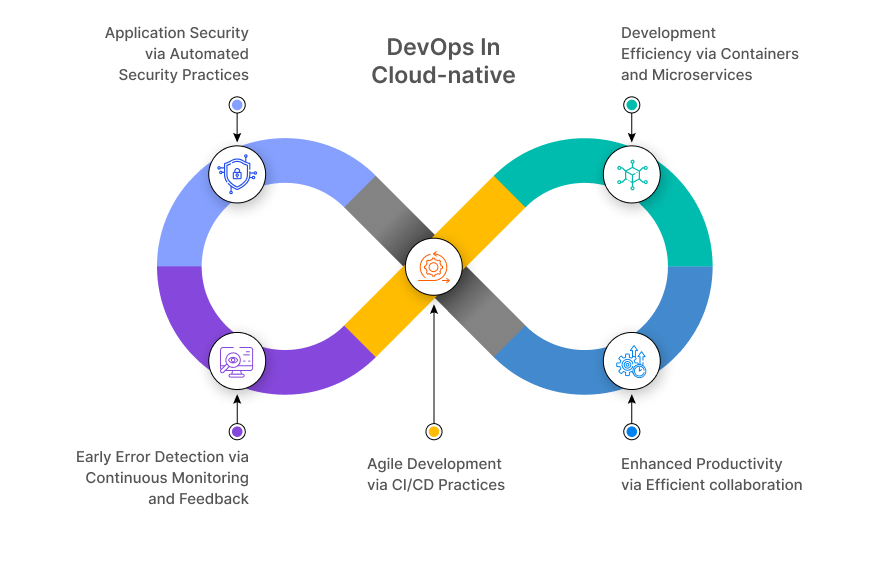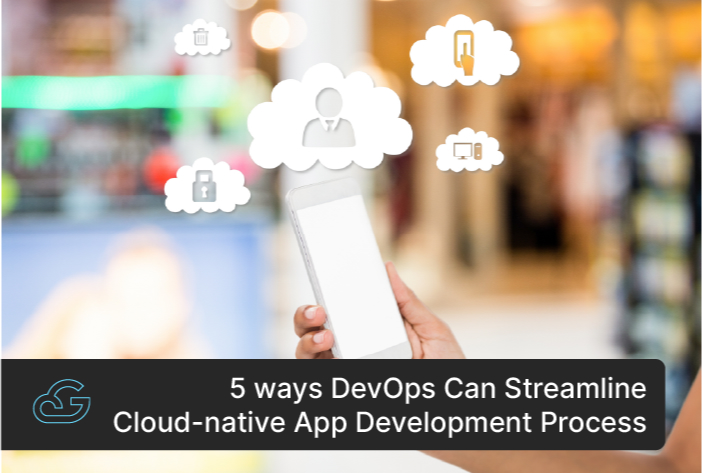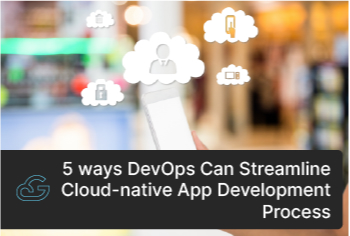Blogs / Cloud Native Development
5 Ways DevOps Can Streamline Cloud-Native App Development Process
By
Vineeth Babu
Posted: February 24, 2023
• 4 Min Read
Cloud-native is not just a buzzword; it's a powerful approach that can fuel innovation and drive transformative change in enterprises. Cloud-native development has numerous advantages, but it can also be highly complex and pose significant challenges that demand specialized management and expertise. DevOps plays a crucial role in enabling organizations to navigate these complexities effectively. It allows businesses to streamline the app development process while offering benefits such as faster time-to-market, cost efficiency, and enhanced collaboration to name a few.

DevOps is a methodology that emphasizes collaboration, automation, and continuous delivery that enables organizations to release high-quality software faster and more reliably. It allows the development (Dev) and operations (Ops) teams to work efficiently throughout the entire software development lifecycle. When combined with the game-changing principles of DevOps, cloud-native development can supercharge an organization's efficiency like never before.
Let’s explore how cloud-native and DevOps work together to drive growth and deliver success in your business.
How DevOps Can Streamline Cloud-Native App Development Process?
Let’s explore how cloud-native and DevOps work together to drive growth and deliver success in your business.
- Agile Development via CI/CD Practices
- Development Efficiency via Containers and Microservices
- Enhanced Productivity via Efficient Collaboration
- Early Error Detection via Continuous Monitoring and Feedback
- Application Security via Automated Security Practices
Cloud-native application development is becoming increasingly popular as businesses look to embrace agile methodologies to foster innovation and efficiency. By aligning people, processes, practices, and technologies, DevOps creates an agile and transparent app development environment that can lead to significant reductions in latency and glitches.
Cloud-native development utilizes DevOps practices like Continuous Integration and Continuous Delivery (CI/CD) to automate the entire software delivery process - from code changes to deployment. By automating the testing, building, and deployment process, your team can reduce the risk of errors and ensure that the software is always up-to-date and functioning properly. This process takes place in an ongoing cycle in a fast-paced and continuous manner, allowing them to deliver software changes more frequently and reliably.
Containers and microservices architecture enables DevOps teams to build, test, and deploy cloud-native applications at scale with greater speed and efficiency. By providing a consistent and reproducible environment for development and operations, containers simplify the process of software delivery, while microservices architecture enables agile development and deployment of services. Let’s learn how.
Microservices architecture decomposes large, monolithic applications into smaller, independent services that can be developed, tested, and deployed independently. This simplifies the tech stack and enhances productivity, as smaller services can be developed and updated faster than larger ones. It also enables distributed teams to work together seamlessly, as each team can focus on developing and maintaining its own microservices.
Containers offer a lightweight and portable solution for packaging small microservices or software processes within a larger application, along with their dependencies. This enables developers to establish a consistent and reproducible environment for testing and deployment purposes. This helps in modernizing legacy systems and reducing the cost of infrastructure operations. By eliminating application conflicts and promoting seamless collaboration through a unified platform for development and operations, containers help to ensure effortless deployment.
Collaboration in cloud-native development refers to the process of working together in a team to build and deploy software applications that are designed to run in cloud environments. This involves communicating and coordinating tasks between different team members, such as developers, testers, and operations personnel, to ensure that the application is developed and deployed successfully.
DevOps practices such as agile methodologies, and code reviews can help your team to collaborate more effectively and deliver better software. For example, agile methodologies such as Scrum and Kanban promote collaboration and communication between your team members by emphasizing the importance of daily stand-up meetings and regular retrospectives. These meetings allow them to share progress updates, identify roadblocks, and discuss potential solutions. By regularly communicating with one another, they can build a shared understanding of the project and work more effectively together.
Similarly, code reviews involve analyzing and providing constructive feedback on code changes made by others. This collaborative process helps identify bugs, ensure high code quality, and foster a culture of continuous learning and improvement.
Continuous monitoring and feedback loops are two key practices in DevOps that can help your team identify issues early and resolve them quickly. This involves real-time monitoring of your application’s performance, security, and infrastructure in production in real-time. With the help of tools that monitor logs, metrics, and other data points, it helps teams identify issues such as bugs, performance bottlenecks, security vulnerabilities, and infrastructure failures.
Feedback loops are performed by providing necessary responses to developers and operations teams on the performance of your application and infrastructure. This can include feedback on the quality of the code, the performance of the application, and the efficiency of the deployment process. Executing this on a regular basis allows your team to identify areas for improvement and make necessary adjustments to improve the overall performance of the system.
Security is a top priority in cloud-native development. With sensitive data and critical applications running in the cloud, your team needs to ensure that the applications are secure and compliant with industry standards. DevOps practices such as automated security testing, compliance checks, and continuous monitoring help them to ensure that the application is secure and compliant.
DevOps utilizes automated security testing tools to scan code for security vulnerabilities, such as SQL injection attacks. This type of testing can be integrated into the development process to catch security issues early before they are deployed to production. Similarly, DevOps allows your teams to utilize automated tools to check for compliance and regulatory requirements during the development process and address any issues before application deployment.
The Bottomline
Cloud-native and DevOps are a perfect mix for organizations looking to embark on their digital transformation journey. If planned and executed well, they create a synergy that results in a significant increase in business performance. Therefore, prioritize cloud-native and DevOps if you want to be better positioned to succeed in today's highly competitive market. Contact us if your business needs cloud computing solutions to facilitate your digital transformation journey.


Get Know More About Our Services and Products
Reach to us if you have any queries on any of our products or Services.











